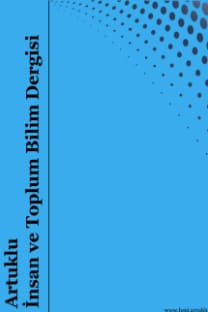19. Yüzyıl Batılı Seyyahlarının Antik Dara (Anastasiopolis) Şehri ile İlgili Gözlemleri
Bugün Mardin il sınırları içerisinde bulunan Dara antik şehri, erken Bizans döneminde imparatorluğun doğu sınırındaki en önemli şehirlerinden biri olmuştur. I. Anastasius döneminde bir garnizon şehri olarak tanzim edilen Dara, I. Justinian döneminde imparatorluğun doğu sınırında yerleşen en sağlam kalesi haline geldi. Dara, bu tarihten itibaren Sasaniler tarafından sık sık saldırı ve kuşatmalara maruz kaldı. Sasani kralları I. Hüsrev Anuşirvan 574’te, II. Hüsrev de 604 yılında Dara’yı kısa süreli ele geçirdi. 640’ta gerçekleşen İslam hâkimiyeti sonrasında sınır hattındaki önemini yitiren şehir bu tarihten sonra derin bir sessizliğe gömüldü. Bugün şehirde var olan mimari kalıntıların çoğu erken Bizans dönemine tarihlenir. Dara, 19. yüzyılda batılı seyyahları tarafından sıkça ziyaret edilmiştir. Bu makalede adı geçen asırda şehre uğrayan seyyahların gözlemleri karşılaştırmalı olarak ele alınacak ve Dara’nın o dönemki mimari ve sosyal durumu tespit edilmeye çalışılacaktır.
Observations of Western Travellers about Ancient Dara (Anastasiopolis) in the 19th Century
Dara, an ancient city, located within the boundaries of Mardin province, was one of the most important cities at the eastern border during the early Byzatine age. In the period of Anastasius I, it was arranged as a fortress city. It has become the strongest city of the empire during Justinianos I age, because of reinforced fortifications. Dara was exposed to many sieges and attacks by Sasanids after this age. It was captured by Sasanian king Khousraw I in 574 and Khousraw II in 604 for a short time. With the beginning of the Islamic period in 640 the city was silenced and, today, most of the architectural remains at Dara belong to early Byzantine time. Dara was frequently visited by western travellers during the 19th century. In this article I will try to consider observations of these travellers comparatively and identify the architectural and social conditions of Dara city in that century.
Keywords:
Dara, J. M. Kinneir, J. S. Buckingham, W. F. Ainsworth, J. P. Fletcher, H. Southgate O. H. Parry,
___
- A Handbook of Mesopotamia (1917). Northern Mesopotamia And Central Kurdistan, vol. IV. Prepared on Behalf of The Admiralty And The War Office.
- Ainsworth, W. F. (1842). Travels and researches in Asia Minor Mesopotamia, Chaldea and Armenia (II. Cilt). London: John W. Parker.
- Al-Istakhri, A. I. A. (1927). Kitab-ı mesalik ve’l memalik. M. J. Goeje (Ed.). In Bibloetheca geographorum arabicorum içinde (Cilt: a). Leiden: E. J. Brill.
- Al-Mokaddasi (1877). Kitabu’l shsanu’l taksim fi marifetu’l akalim. M. J. Goeje (Ed.). Bibloetheca geographorum arabicorum (III. Cilt). Leiden: E. J. Brill.
- Badger, G. P. (1852). Nestorians and their rituals with the narrative of mission to Mesopotamia And Coordistan in 1842-1844, (I. Cilt). London: Joseph Masters.
- Buckingham, J. S. (1827). Travels In Mesopotamia, London: Henry Colburn.
- Chesney, F. R. (1868). Narrative of the Euphrates expedition, carried on by order of the British government during the years 1835, 1836, and 1837. London: Longmans Green & Co.
- Croke, B. & Crow, J. (1983). Procopius and Dara, The Journal of Roman Studies, 73, 143-159.
- De Menbidj, A. (Mahboub). (1912). Kitab al-unvan (Arapça Metin ve Fr. çev. A. A. Vasilev). Patrologia orientalis (VIII. Cilt), (s. 397-550). Paris: Allemagne Et Autriche –Hongrie.
- Ebn Haukal (1800). The Oriental geography (Kitab-ı mesalik ve’l memalik) (İng. çev. W. Ouseley). London: Oriental Press by Wilson & Co.
- Edrisi (1840). Geographie d’edrisi (Kitabu’l nuzhatü’l müştak fi ihtiraku’l afak) (Fr. çev. A. Jaubert) (II. Cilt). Paris: A L’ Imprimerie Royale.
- Evagrius (1854). History of the church (431-594) (Translated from Greek: Memoirs of The Authors). London: Henry G. Bohn.
- Fletcher, J. P. (1850). Notes from nineveh and travels in Mesopotamia, Assyria And Syria. Philedelphia: Lea and Blanchard.
- Gregory Abu’l Farac (Bar Habraeus) (1999). Abu’l-Farac tarihi (Çev. Ö. R. Doğrul), (I. Cilt). Ankara: TTK Yayınları.
- İbn Battuta Tanci, Ebu Abdullah Muhammed (2004). İbn Battuta Seyahatnamesi (Çeviri, inceleme ve notlar: A. S. Aykut) (I. Cilt). İstanbul: Yapı Kredi Yayınları.
- İbn Cübeyr (2003). Endülüs’ten kutsal topraklara (Çev. İ. Güler). Selenge Yayınları: İstanbul.
- John of Ephesus (1860). The third part of Ecclessiestical history of John Bishop of Ephesus. Oxford: Oxford University Press.
- Kinneir, J. M. (1813). Geographical memoir of the Persain Empire. London: Printed for John Murray.
- Kinneir, J. M. (1818). Journey through Asia Minor, Armenia and Koordistan, in the years 1813 and 1814. London: John Murray.
- Parry, O. H. (1895). Six months in a Syrian monastery. London: Horace Cox.
- Sebeos (1999). The Armenian history attributed to Sebeos. Liverpool: Liverpool University Press.
- Southgate, H. (1844). Narrative of a visit to the Syrian (Jacobite) church of Mesopotamia, state of Christianity in Turkey. New York: D. Appleton and Co.
- Weiskopf, M. (1993). Dara. E. Yarshater (Ed.) Encyclopedia Iranica içinde (VI. Cilt) (s. 671-672). Mazda Publishers.
- Zachariah of Mtylene (1899). The Syriac chronicle known as that of Zachariah mtylene. London: Methuen & Co.
- Yayın Aralığı: Yılda 2 Sayı
- Başlangıç: 2016
- Yayıncı: Mardin Artuklu Üniversitesi
